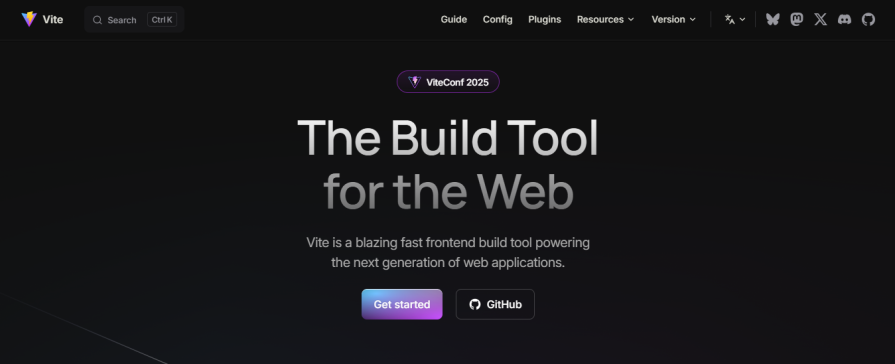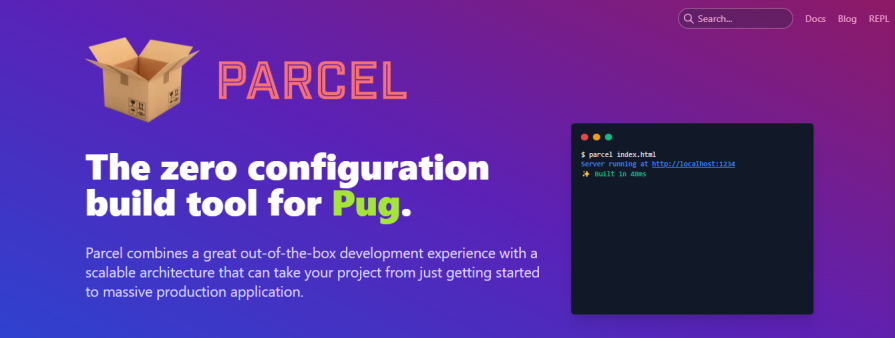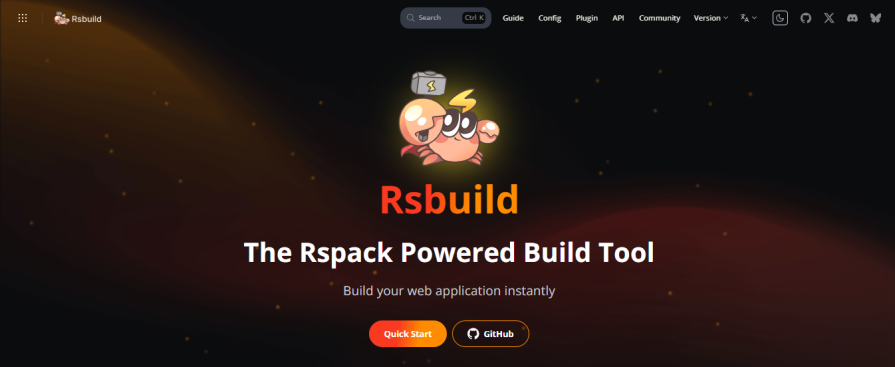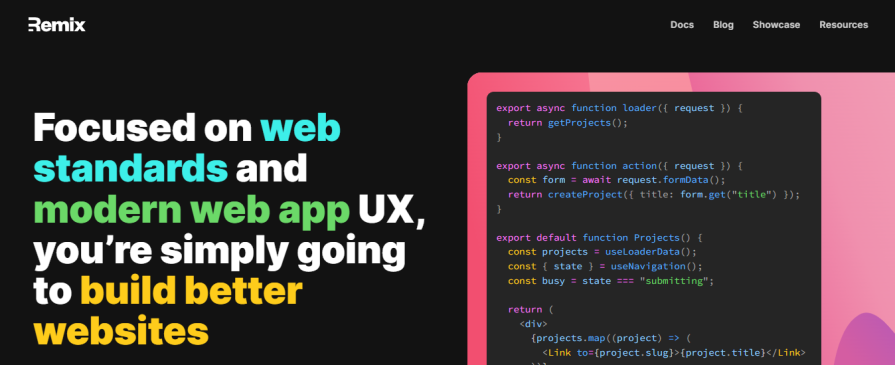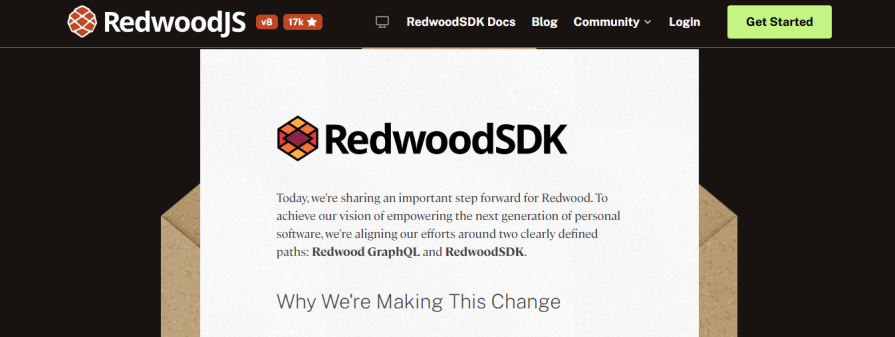The 9 best Create React App alternatives
In this post, we’ll discuss nine alternatives to Create React App, which was deprecated in February 2025:
- Vite
- Parcel
- Rsbuild
- Next.js
- Remix
- React Router
- Expo
- Tanstack Start
- RedwoodJS
Since its release in 2016, Create React App (CRA) has been one of the go-to tools for spinning up new React applications. However, in recent years, the React team has been encouraging developers to move away from CRA to other tools in the React ecosystem.
As of February 14, 2025, CRA has been officially deprecated. While it’s still technically usable, it is no longer being maintained, meaning it won’t receive updates, security patches, or improvements. For long-term projects, continuing to use CRA is not advisable.
So, what should React developers use instead? In this article, we’ll explore some of the best alternatives to CRA and how they can help you build modern React applications more efficiently.
Why the React team deprecated Create React App
Create React App offered an easy, low-configuration solution for setting up React projects. It combined tools like JSX, linting, and hot reloading into a single configuration, speeding up the process of bootstrapping React apps.
“Well then, why was it deprecated?” you ask. Here are some reasons:
Outdated build system
The JavaScript ecosystem evolved over time, and CRA’s build system became outdated. Modern tools like Vite, Parcel, and Rsbuild have emerged, and they offer significantly faster builds and improved performance. CRA, which still relies on webpack, struggled to keep up with these advancements.
Poor performance and developer experience
CRA’s slow build times and inefficient bundling made it difficult for developers to maintain a smooth workflow. Its hot module replacement (HMR) was also not as fast as other solutions, which made it slower by comparison. Similarly, its poor tree-shaking led to larger bundle sizes and slower load times.
Lack of built-in features for modern React apps
Modern React apps need more than just a basic setup. Features like server-side rendering (SSR), static site generation (SSG), code-splitting, routing, and data fetching optimizations have become essential. CRA, being a client-side tool, did not support these features out of the box.
No active maintainers
CRA had become difficult to maintain, and with no dedicated team actively working on updates, it became outdated.
The React team’s shift toward frameworks
Instead of relying on boilerplate tools like CRA, the React ecosystem has been moving toward opinionated frameworks that provide end-to-end solutions for building applications.
The best Create React App alternatives
Having understood the React team’s motivation for deprecating CRA, let’s explore alternative solutions, starting with the build tools the team recommended.
1. Vite
Vite is a modern frontend build tool that provides an extremely fast development environment for React applications. Unlike CRA, which uses webpack, Vite uses esbuild and native ES modules, resulting in near-instant cold starts and fast HMR.
Features
- Lightning-fast development server powered by esbuild
- Native support for TypeScript, JSX, and CSS preprocessors
- Optimized production builds with Rollup
- On-demand module loading instead of bundling everything upfront
- Supports code splitting and tree shaking out of the box
- Works seamlessly with React, Vue, and other frameworks
Use cases
Vite is well-suited for small to large React projects that need fast builds. It’s a great tool to work with if you need a performant webpack alternative that requires minimal configuration. It’s also a good fit for apps that don’t need SSR or SSG.
Resources for further learning
- Getting started with Vite
- Vite adoption guide: Overview, examples, and alternatives
- Vitest adoption guide: Overview, examples, and alternatives
- Vite 3.0 vs. Create React App: Comparison and migration guide
- Setting up a dev environment with React, Vite, and Tailwind
- How to build a React + TypeScript app with Vite
- How to build scalable micro-frontends with Vike and Vite
- Full-stack DApp tutorial with Vite + React, Tailwind CSS, and Solidity
2. Parcel
Parcel is a zero-configuration build tool that aims to simplify the setup process for web applications. It automatically handles code splitting, hot module replacement, and asset bundling without the need for extensive configuration.
Features
- Zero configuration setup
- Automatic code splitting
- Built-in support for various asset types (JS, CSS, images, etc.)
- Multi-core architecture that uses all CPU, resulting in faster builds
- JavaScript compiler is written in Rust, making it 10-20 times faster than JavaScript-based tools
Use cases
Parcel is a good fit for developers who prefer convention over configuration and want to get started quickly without manual setup.
Resources for further learning
- What you need to know about Parcel 2
- Benchmarking bundlers 2020: Rollup vs. Parcel vs. webpack
- Getting started with Parcel CSS
3. Rsbuild
Rsbuild is a modern build tool powered by Rspack, a high-performance JavaScript bundler written in Rust. It offers speed and efficiency and supports various frameworks, making it a solid choice for applications of all sizes.
Features
- Built on Rspack, a Rust-powered bundler with a Webpack-compatible API
- High-performance bundling
- Built-in support for TypeScript and JSX
- Combines Rust and TypeScript for parallelized builds
- Lightweight plugin-based system for extensibility
Use cases
Rsbuild is great for projects where build performance is critical.
Resources for further learning
- Rsbuild quick start
- Rsbuild is 3x faster than Vite
- Set up a React app with Rspack/Rsbuild
- Why you should migrate to Rspack from webpack
That’s it for the build tools. Now, let’s explore the alternative frameworks and libraries that the React team recommended.
4. Next.js
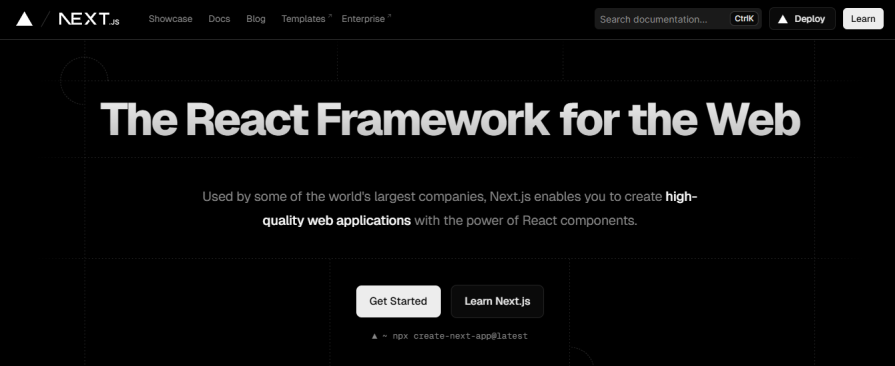
Next.js has become widely used in the React ecosystem and is known as one of the most popular React frameworks.
Features
- App router
- Built-in CSS and Sass support
- Support for SSR and SSG out of the box
- React server components
- Route handlers
- Embedded optimizations for images, fonts, and scripts via custom components
- Optimized performance with automatic code-splitting
Use cases
Next.js is suitable for building server-rendered applications, static websites, and projects that require SEO optimization and fast page loads.
Resources for further learning
- Next.js vs. React: The developer experience
- Next.js vs. Nuxt.js: Ultimate guide
- Build a full-stack app with Next.js and Supabase
- Handling data fetching in Next.js with useSWR
- Understanding state management in Next.js
- LogRocket’s Next.js archive
5. Remix
Remix is a full-stack React metaframework developed by the creators of React Router. Commonly known as Next.js’ competitor, Remix has cemented its place in the React ecosystem.
Features
- Data loading mechanism for fetching data at both the route and page levels
- Built-in support for server-side rendering
- Built-in caching
- Form handling API and embedded validation mechanisms
- Nested routing system for structuring apps in a modular way
Use cases
Remix is great for building dynamic, data-driven applications where performance is a focus.
Resources for further learning
- Remix: A guide to the React framework taking on Next.js
- Remix vs. Next.js vs. SvelteKit
- Building a full-stack app with Remix and Prisma
- Handling user authentication with Remix
- Remix and Supabase: Build a real-time chat app
- LogRocket’s Remix archive
6. React Router

Features
- Declarative routing
- Dynamic route matching
- Nested routing
- Route redirects
- Data mutations via Route actions.
Use cases
React Router is ideal for single-page applications that need dynamic routing and complex navigation structures.
Resources for further learning
- Server-side rendering with React Router v7
- Authentication with React Router v6: A complete guide
- Using Hooks with React Router
- Exploring React Router’s data, navigation, and error handling APIs
- Migrating to React Router v6: A complete guide
7. Expo
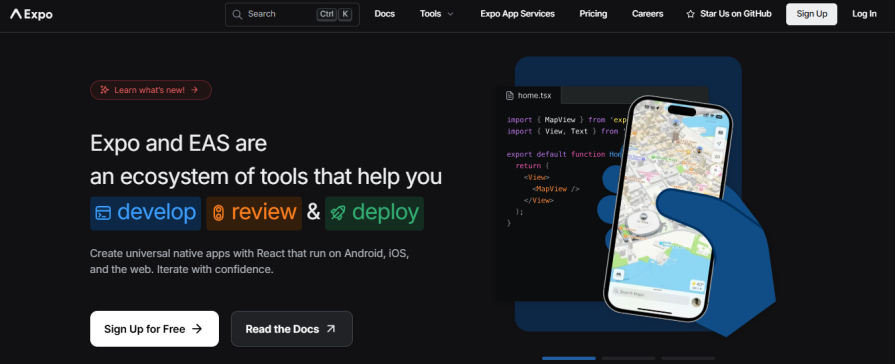
With Expo, you can write your application in a single codebase and deploy it across multiple platforms, eliminating the need to write separate code for iOS and Android.
Features
- Expo provides a library of pre-built components
- Cross-platform compatibility
- Supports live and hot reloading
- Expo Orbit, a desktop application for building, launching, and managing apps on simulators and real devices
- Over-the-air updates that allow you to push updates to users without going through the app store review process
Use cases
Expo is suited for developers building cross-platform apps.
Resources for further learning
- Building cross-platform apps with Expo instead of React Native
- Expo Router adoption guide: Overview, examples, and alternatives
- Getting started with React Native and Expo SDK
- Mastering Stripe PaymentSheet in React Native with Expo
8. Tanstack Start
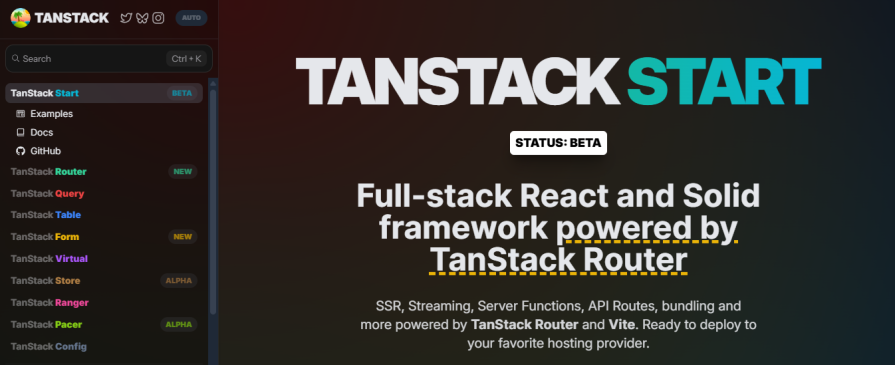
Features
- Isomorphic loaders that run on the server during the initial page load and on the client during subsequent navigations
- Supports SSR
- Seamlessly integrates with React Query for component-level data fetching
- Supports out-of-order streaming, allowing slow data to be sent to the browser after the initial render
Use cases
Tanstack Start is ideal for data-intensive apps that need efficient data fetching and caching. It’s also a good fit for SEO-critical projects since it supports SSR.
Resources for further learning
- TanStack Start overview
- Introducing TanStack Start
- Learn TanStack Start in 7 Minutes
- An Early Glimpse of TanStack Start
- TanStack Start: A Full-Stack React Framework but Client-First
9. RedwoodJS
RedwoodJS is an opinionated, full-stack web framework designed to help projects scale from side projects to startups. It combines tools like React, GraphQL, Prisma, TypeScript, Jest, and Storybook to provide an end-to-end development workflow.
Features
- Combines popular libraries and tools
- Supports both client-side and server-side rendering on a per-page basis
- Built on React Server Components and Server Actions, simplifying common data fetching and form submission tasks
Use cases
Redwood is designed to support applications scaling from small projects to full-fledged startups. It is also ideal for building Jamstack apps without the complexity of setting up static site generators or a headless CMS.
Resources for further learning
- Getting started with RedwoodJS
- Blitz.js vs. RedwoodJS
- How to build a full-stack app in RedwoodJS
- Leveraging React Server Components in RedwoodJS
How to migrate from Create React App
Here are some tips and best practices to follow when migrating from Create React App:
Assess your current project
Before migrating, assess your current project to understand its structure, dependencies, and custom configurations. Identify any CRA-specific features or ejected webpack configurations that may need to be replaced.
Choose the right alternative based on project needs
Different tools offer different benefits, so choose the best alternative based on your project’s needs. Note that the alternative you choose will affect the migration process because each tool has a different architecture, configuration style, and feature set.
For example, Vite relies on ES modules and requires moving index.html to the root directory while replacing react-scripts with vite commands.
If you choose Next.js, you will need to refactor your routing system — which will change your application’s and folder’s structure — since it uses file-based routing instead of React Router.
Perform the migration in stages
It’s always best to execute your migration in stages instead of all at once. The former reduces the chances of risks, downtime, and disruptions in case anything breaks during the process.
While the exact process may differ, the phased migration could look like this:
- Proof of concept — Set up a small proof-of-concept (POC) project with your chosen alternative. This allows you to experiment with the new tool, learn its features, understand its structure, and identify potential migration challenges
- Less critical components — Instead of migrating the entire application, begin with less critical components that don’t affect core functionality, like global UI components, static pages, and layout components. This allows testing of the new environment without breaking key functionality
- CRA-specific code — After that, begin migrating CRA-specific code, switching necessary environment variables, and updating package scripts
- More critical components — Once the smaller components and supporting code have been migrated, move to the critical parts of the app, including user authentication, state management, and API integrations
Execute post-migration activities
The journey doesn’t end with migrating all components and dependencies. You also need to perform post-migration tasks to ensure your application runs smoothly in production. These include activities like:
- Thorough testing to verify that all pages and components work as expected. You can run unit, integration, and end-to-end tests
- Performance optimization with code splitting and lazy loading to reduce bundle size
- Cleaning up unused CRA-specific dependencies
- Deleting outdated configurations
- Updating documentation like README files
- Integrating tools like LogRocket for tracking errors and monitoring performance. Request a demo or sign up for free
- Deploying the updated app to a staging environment for final testing and performing a gradual rollout to monitor real-world performance.
Conclusion: Migration success stories and learning resources
No man is an island. Luckily, and thankfully, you don’t need to figure out the migration process from scratch. The ecosystem is full of teams that have successfully migrated from one tool to another, and tutorials you can learn from:
- Stripe migrated millions of lines of code to TypeScript
- How Faire transitioned from SPA to Next.js
- Flotiq: Why we migrated our blog to Next.js
- Peerlist: Everything about our migration from ReactJS to Next.js
Explore these resources to aid you as you migrate:
- Next.js docs: Migrating from Create React App
- Rsbuild docs: Migrate from Create React App
- Migrate to Vite from Create React App
- Why you should migrate to Rspack from webpack
- The guide to converting Angular apps to React
With all we’ve discussed in this article and the various resources highlighted, you’re set for a successful migration from Create React App.
The post The 9 best Create React App alternatives appeared first on LogRocket Blog.
This post first appeared on Read More



